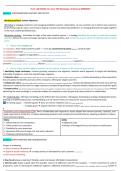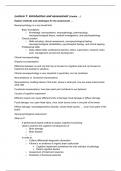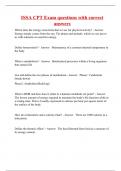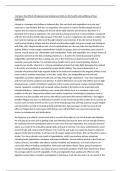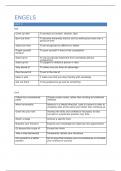Child Maltreatment and Risk for Psychopathology in Childhood and Adulthood ~ Jaffee et al.
The following studies al include the following features:
1. A prospective research design in which maltreatment predated the onset of psychopathology
2. A demographically matched control sample or statistical adjustments for variables that could
confound the association between maltreatment and risk for psychopathology.
3. Psychometrically valid measures of psychopathology including diagnostic measures.
Maltreatment and risk for externalizing and internalizing psychopathology
- Victims of maltreatment are at elevated risk for a range of externalizing problems in
childhood and adolescence: ADHD, conduct disorder, oppositional defiant disorder,
delinquency and antisocial behavior.
o These problems extend into adulthood, when they have significantly elevated rates
of antisocial personality disorder, self-reported crime and criminal arrests. Findings
with respect to drug and alcohol use have been mixed.
- Victims of maltreatment are also at risk for a range of internalinzing problems in childhood:
major depressive disorder, anxiety disorders, posttraumatic stress disorder and symptoms of
trauma, and internalizing symptoms.
o These problems extend into adulthood, when they have significantly elevated rates
of major depressive disorder, depressive symptoms, and anxiety disorders.
- Maltreatment increases risk for PTSD in adulthood via at least two pathways:
o Maltreated youth are at heightened risk for mental disorders in childhood and
adolescence, and a history of mental health problems increases the risk that an adult
who experiences a trauma will develop PTSD.
o Independent of juvenile disorder, maltreatment sensitizes the neurobiological
response to subsequent trauma, increasing the risk that an adult who experiences
trauma will develop PTSD.
Maltreatment and risk for personality disorders, psychotic symptoms, and suicide
- Victims are at risk for borderline personality disorder, Cluster B (dramatic, emotional, erratic)
and Cluster C (anxious, fearful) personality disorder. They are also at elevated risk for suicide
in adolescence and adulthood and engage in elevated rates of self-injury.
Causal status of effects
- Research designs that match maltreated children with sociodemographically similar,
nonmaltreated youth may be, the most feasible way of estimating the unique effects of
maltreatment on risk for psychopathology, and these designs do a good job of ruling out the
possibility that nongenetic factors confound observed associations between maltreatment
and child or adult psychopathology.
Intergenerational transmission of maltreatment
- The cycle of violence is not inevitable. The majority of adults who were victimized as children
do not themselves perpetrate abuse or neglect.
- Child protective services has a bias to investigate and substantiate cases of abuse or neglect
when they know the parent has a history of maltreatment. Thus, detection bias may inflate
estimates of the intergenerational transmission of maltreatment.
,Mediators of maltreatment effects
Hypervigilance to threat
- Attention bias refers to the tendency to devote disproportionate attention to relatively mild
threats. Children could become sensitized to threatening stimuli because of their early
exposure to anger and other negative emotions in families characterized by nonnormative
parenting. This sensitization to threat could then increase children’s risk for anxiety.
o Not al studies of maltreated children find that their attention bias is toward
threatening stimuli. At lest two studies have found that children who have been
maltreated have an attentional bias away from threat in the dot probe task.
- Maltreated children exhibit heightened amygdala reactivity to threat cues compared with
non-maltreated children. They also have a heightened right amygdala reactivity to angry and
fearful versus neutral faces in psychiatrically healthy adults and bilateral amygdala reactivity
to emotional faces versus neutral ones.
- Maltreated youth are more likely than nonmaltreated youth to have social information
processing styles characterized by a tendency to attribute hostile intent to others whose
behavior is ambiguous.
o Physically abused children engage in higher rates of aggressive behavior partly
because of their hostility bias.
Deficits in emotion recognition
- Abusive parents model atypical facial expressions and may also model ways of responding to
children’s emotions that increase children’s risk for emotion regulation problems.
- Maltreated youth are poorer than nonmaltreated youth at accurately identifying facial
expressions of emotion.
- Maltreated youth also have difficulties matching emotional outcomes with their common
elicitors.
Reward responsiveness
- Reduces responsiveness to rewars is hypothesized to be a neural mechanism by which
maltreatment increases risk for depression. Maltreated children and adults who were
maltreated as children are less sensitive to cues for reward than nonmaltreated controls.
o Mesolimbic dopamingeric circuitry that project to the basal ganglia is involved in
responsivity to reward and particularly in anticipation of reward.
- Researchers have hypothesized that the relatively slow maturation of the anterior cingulate
cortex (ACC) leaves it vulnerable to the psychological sequelae of chronic stressors, such as
maltreatment, that leas to excessive release of glucocorticoids as part of the stress response.
o Childhood sexual abuse affects development of the ACC, thus affecting the ability to
learn form positive experiences and perpetuating maladaptive decision making that
may increase risk for depression.
Moderators of child maltreatment
Moderators of maltreatment can be conceptualized as factors that exacerbate effects of
maltreatment on risk for psychopathology or as factors that promote competence in mental health,
academic, or interpersonal domains despite exposure to maltreatment.
- Maltreatment that is chronic tends to me more strongly associated with risk for
psychopathology than maltreatment that occurs sporadically.
, - Maltreatment that is first experienced in childhood is more strongly associated with
internalizing outcomes than maltreatment that is first experienced in adolescence, the
reverse is true with respect to externalizing problems.
Genetic moderators of maltreatment effects
MAOA x maltreatment
- The MAOA gene is involved in the metabolism of dopamine, serotonin and norepinephrine.
- One study showed that men who had experience childhood maltreatment had elevated
levels of childhood conduct and adult antisocial behavior problems if thery carried the low
activity variant of the MAOA gene. Men who carried the high activity variant of the MAOA
gene were not at elevated risk for antisocial outcomes regardless of their exposure to
childhood maltreatment.
- The pattern of effects for women may be reversed.
5-HTTLPR x maltreatment
- 5-HTTLPR is a 43-base pair insertion/deletion polymorphism. The serotonin transporter (5-
HTT) plays a vital role in the regulation of serotonin reuptake, and dysregulated serotonin
functioning is associated with both depression and aggression.
- Among individuals who were homozygous for the short form of the serotonin transporter
allele, a childhood history of maltreatment was associated with elevated risk for depression
and depressive symptomatology in adulthood.
- Risk for depression may be elevated among individuals who carry the 5-HTTLPR S allele
because these individuals have more pronounced physiological response to stress than L
allele carriers.
o At this point, it is not clear what roles gene expression and methylation play in
explaining why S allele carriers who are exposed to maltreatment are at elevated risk
for depression.
Psychosocial moderator of maltreatment
- Children who are resilient to maltreatment tend to be characterized by high ego control and
ego resiliency, high self-esteem, high self-reliance, and the tendency to attribute successes to
their own effort.
- High levels of social support reduce rates of psychopathology to the same low levels as in
children or adults without histories of maltreatment.
o Findings are mixed as to whether social support specifically benefits women or men.
- The causal role of social support as a buffering factor, direct protective factor, or mediator is
difficult to establish, given that individual differences in temperament or personality could
alter an individual’s perception that social support is being provided, their satisfaction with
the provision of support, or their actual receipt of support.
o Direct protective effect: in the sense that having social support is beneficial
regardless of a person’s maltreatment history.
Paradise Lost: The Neurobiological and Clinical Consequences of Child Abuse and Neglect ~
Nemeroff
Epidemiology and clinical course
ELS = Early Life stress

